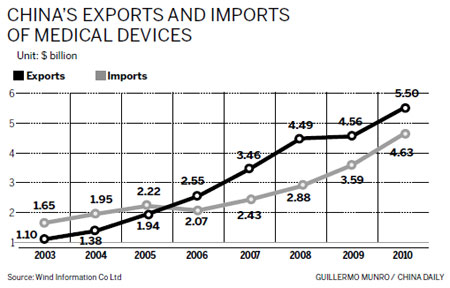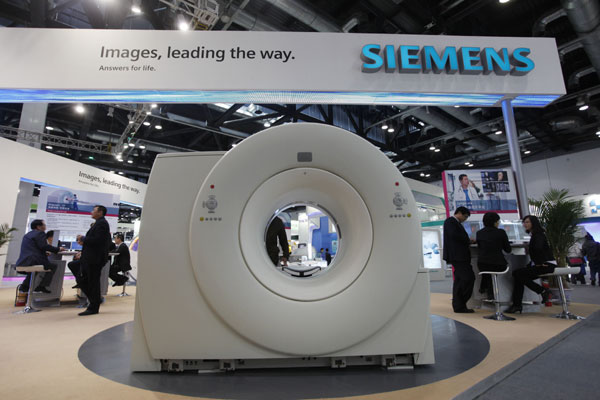Made in China 'for the world'
Updated: 2012-07-26 08:00
By Liu Jie in Shenzhen (China Daily)
|
|||||||||||

|
A Siemens AG magnetic resonance imaging system at a trade show in Beijing in March. For the past five years, nearly 60 percent of China's medical equipment exports have been from multinational companies and Sino-foreign joint ventures. A Jing / for China Daily |
Multinationals establish more research facilities as nation's reputation for R&D and design increases
The global giant Siemens Healthcare has just delivered its 1,000th Magnetom Essenza, made in Shenzhen, to Tokushukai, a hospital group in Japan.
So far, more than 70 percent of the market-leading imaging devices - one of the German company's most competitive products in the international market - have been exported from the factory to markets around the world.
"Created and developed in China, and made by Siemens," said Bernd Ohnesorge, CEO of the MR business unit at Siemens Healthcare, adding that the company's powerful 1.5-tesla magnetic resonance imaging system was globally launched five years ago by Shenzhen Siemens Magnetic Resonance Ltd.
The Shenzhen facility is one of Siemens Healthcare MR's three R&D and manufacturing headquarters around the world, the other two being in Erlangen, Germany, and Oxford, in the United Kingdom.
The Shenzhen base recently also developed the company's latest MRI system and sent the first products to sites in Germany, Japan and China for clinical trials, according to Ohnesorge.
"Our clients are very satisfied with it, and we hope the machine can also be used in China soon with SFDA (State Food and Drug Administration) approval."
China has fast become the manufacturing center for a growing list of multinational medical equipment manufacturers, producing sophisticated imaging systems which can compete with anything produced elsewhere in the world.
But now it is also growing its reputation as an R&D hub.
Multinational medical device providers are exporting products not only made in China, but also designed in China, according to Cai Tianzhi, director of the medical device department of the China Chamber of Commerce for Import and Export of Medicine and Healthcare Products.
And he predicts the proportion of China-designed exports will continue to rise.
Statistics from the General Administration of Customs show that for the past five years, nearly 60 percent of China's medical equipment exports have been from multinational companies and Sino-foreign joint ventures.
The nation's medical equipment exports were worth $15.71 billion last year, an increase of 17.36 percent year-on-year.
"We have seen more and more foreign medical device companies setting up R&D facilities in China, or even moving their regional R&D centers to China," added Liu Ximei, an analyst with the research company Forward Business Intelligence Co Ltd.
"Their exports are becoming more sophisticated, and more products are being developed in China for global use."
The US giant General Electric Co first proposed the idea of doing R&D in emerging economies for the global market in 2009, and its medical offshoot GE Healthcare first tested the water in China.
GE Healthcare's imaging market leader, the Brivo CT series, was developed in China in 2010, its small size and affordable price aimed primarily at China's county-level hospitals.
Now, besides meeting demand from China's grassroots medical institutes, 70 percent of GE Brivos, with an average unit price of $15,000, are being exported to markets including developed economies such as the United States and Japan.
Dai Ying, chief technology officer at GE Healthcare China, said that due to the economic slowdown and public concerns about medical costs, governments and medical institutes in developed economies are paying much greater attention to medical cost reduction.
"Their focus is on quality and high efficiency, making products developed for China's grassroots market also suitable for Western clients," he said.
According to Ohnesorge, the needs in China are fast becoming those of other markets, even Europe.
"Advanced technology with affordable costs, what we call accessible innovation, has really triggered our global strategy.
"Easy-to-use, high throughput, high quality, advanced medical imaging - that's something particularly needed in the county-level hospitals in China, but also of importance in medium-sized hospitals in Asia, in Europe, in South America, and even in Germany," he said.
Foreign giants now realize that China is no longer just an appealing manufacturing center.
Their facilities in the country can combine R&D and production, producing high-quality goods in large numbers, managed by highly-qualified local engineers and workers, Liu said.
GE Healthcare established its own innovation center in Chengdu in April - a $500 million investment which serves not only its customers in southwestern, northwestern and central China, but also its US and global network.
"Products developed in Chengdu feed into our global supply chain," said Rachel Duan, president and CEO of GE Healthcare China.
"We had said we are 'in China, for China'. Now we would like to say we are 'in China, for the world'."
GE has completed more than 100 major projects under that "developed in China for the world" umbrella, 10 of them for the medical care sector.
GE Healthcare China added around 200 engineers to its R&D team this year, bringing its total workforce to 1,200.
Cai from the chamber of commerce said that such investment by foreign companies in R&D in China is now acting as a stimulus to domestic players to upgrade their technology to enhance their chances of export success.
This growing commitment to R&D by multinationals has also helped cultivate a burgeoning community of homegrown, quality engineers with a global outlook and international working experience.
Cai said employee turnover within the industry is inevitable, but healthy, helping domestic medical equipment makers strengthen their R&D capabilities.
Shenzhen-based Mindray Medical International Ltd is now considered China's largest medical equipment manufacturer, and its exporter.
Set up in 1991 as a trading company, it is involved in importing medical equipment.
It now has 29 local sales and service offices in China, as well as sales and service subsidiaries in Amsterdam, Istanbul, London, Mexico City, Moscow, Mumbai, Sao Paulo, Seattle, Toronto and Vancouver, and its US offshoot is listed on the New York Stock Exchange.
With years of close connection with various international firms, the device maker realized that to sustain its long-term development, it needed to develop its own products, according to Liu Jie, its corporate operation officer.
The company had been focusing on locally tailored products since the late 1990s, with some success, and its knowledge of local demand and market needs was a valuable resource.
"Learning from international big names, we built our own R&D teams with talent from home and abroad and actively targeted overseas markets with our technology and highly flexible products, at affordable prices. It was a formula that worked," Liu said.
So far, more than half of Mindray's revenues come from overseas, as it exports products to more than 190 countries and regions.
The company's sales revenue hit $880 million last year, a 25 percent year-on-year increase, according to the company's financial report.
It has nearly 1,550 R&D employees, accounting for around one-third of its workforce.

Its engineers work across six R&D facilities in cities around the world, including Shenzhen, Beijing, Nanjing, Seattle and Stockholm.
"We are doing R&D in and outside China, in a bid to meet the needs of our home market and sell products globally," Liu said.
Ohnesorge of Siemens has the same message for his customers around the world, and said more companies are starting to adapt a similar approach.
"In China, we truly create rather than just make," he said.
"We do development here based on our global business, for our global customers."
Contact the writer at liujie@chinadaily.com.cn
Today's Top News
President Xi confident in recovery from quake
H7N9 update: 104 cases, 21 deaths
Telecom workers restore links
Coal mine blast kills 18 in Jilin
Intl scholarship puts China on the map
More bird flu patients discharged
Gold loses sheen, but still a safe bet
US 'turns blind eye to human rights'
Hot Topics
Lunar probe , China growth forecasts, Emission rules get tougher, China seen through 'colored lens', International board,
Editor's Picks

|

|

|

|

|

|






